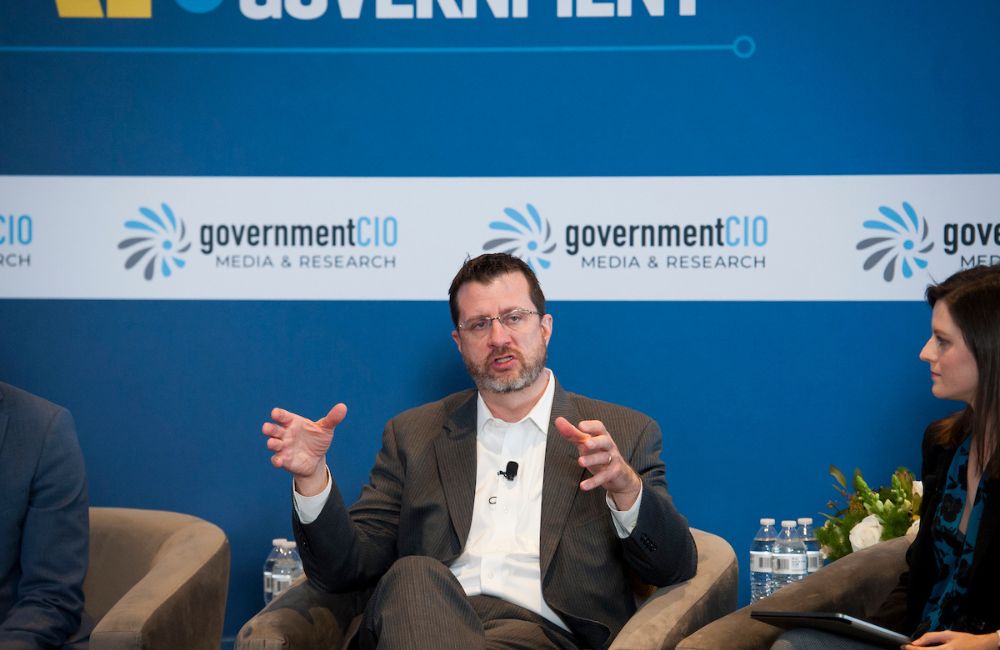Government Leaders Tie Data Strategy to Agency Missions
Data analytics and artificial intelligence processes require a pragmatic, mission-focused approach to innovation.

Federal data scientists are spurring innovation at their agencies through appending data analytics research to core missions and organizational priorities, leaders said at the AI and RPA CXO Tech Forum Dec. 5.
“From a top-down perspective as a chief data officer, I have to flow throughout the organization,” said Kris Rowley, chief data officer of the General Services Administration. “I have to coalesce leadership around common problems, common priorities, common theories.”
Rowley noted that one of his core responsibilities involves overseeing the application of AI and complex analytics, particularly as a means of proving how they might streamline GSA’s essential functions. This involves an organized approach to applying methodology in a top-down fashion.
“What you really need to get started is the upper-level engagement around understanding what the needs, challenges and priorities are, and an accessible route to get these to data practitioners,” Rowley said.
Outlining his approach to automation and AI at the Department of Health and Human Services, HHS Senior Advisor to the CIO Oki Mek noted that digitizing core processing that was previously bound to paperwork will be crucial for creating data strategies that will improve agency functions.
“You have to make sense of data before you have a data strategy … just trying to digitize paper, that would be the first hurdle,” Mek said. “If you can achieve that, you can go onto the next stage of analyzing data and mapping the data.”
This was a foundational step before identifying process redundancies and potential areas of automation, and rectifying these on an agency-wide level.
“For us at HHS, we used machine learning once we digitized the data,” Mek said. This allowed HHS to move onto more sophisticated questions of data structuring and the creation of useful data clusters, he said. Once they had been established, HHS was able to begin performance measures and strategic analysis particular to the agency’s core functions.
Speaking from an industry perspective, NetApp CTO Kirk Kern noted that it has been essential for federal clients to organize their proprietary data before executing a broader data strategy.
“If you look at any successful AI project, it’s highly contingent on having access to massive amounts of data and information,” Kern said.
However, Kern also recognized that finding ways to properly organize and access this data precedes the execution of any kind of data or automation strategy. Agencies are sitting on vast reservoirs of potential data, Kern noted, resulting in government clients creating “data lakes, even data oceans” of both structured and unstructured data.
The solution, Kern proposed, has been the creation of a “polystore” that “lets you store data in its native format … which then gives you the ability to access that data with the appropriate levels of granular access controls.”
Discussing the Department of Veterans Affairs approach to automation and AI innovation, VA Statistician David Maron reiterated the necessity to begin with creating an organized data repository that can feed into AI engines.
“It’s foundational to have quality, clean, uniform data that you can leverage in large quantities,” Maron said. “If you don’t have those in place, you’re not going to be able to trust the outcomes you have with AI.”
The VA has made progress in data organizing and automation.
“Five, six years ago I was working with the medical record data for millions of veterans and having to clean that data manually,” Maron said. “Now we’ve become more sophisticated.”
This has allowed the VA to begin engaging in more advanced AI projects specific to its mission. “What’s exciting is that the VA is now poised to leverage AI in a way that’s unique,” Maron said.
These efforts have enabled increasingly collaborative work on AI development between the VA and outside partners. “One of the main things we’re doing in AI is an AI tech sprint,” Maron revealed.
The VA’s latest tech sprint is poised to advance agency-specific AI application.
“This is a time-limited engagement on a specific use case,” he said. “We just did clinical trial matching for veterans, and this brought in academic and industry partners.”
The initial efforts to structure and categorize proprietary VA data has allowed a new era of innovation at the agency, one that was focused on improving VA services while incorporating external contributions as well.
“There is a back-and-forth in understanding the data, as well as understanding what the problems are,” Maron added. “We’re basically working collaboratively to improve our AI tools.”
This is a carousel with manually rotating slides. Use Next and Previous buttons to navigate or jump to a slide with the slide dots
-

How Agencies are Upskilling the Workforce in AI
Federal officials are putting in place new training and education methods to ensure its overall workforce understands the technology.
3m read -

Building Better Data Governance Across FDA
The agency is using emerging technology to tackle its data challenges.
19m listen -

A Prepared Workforce is Key to Cyber Resiliency
Strong training strategies and emphasizing cyber hygiene basics enhance security practices at federal agencies.
2m read -

Strategies for Effective Data Modernization
Data is the lifeblood of critical decisions and streamlines operations across the government, but many agencies struggle with inconsistent standards.
33m watch




